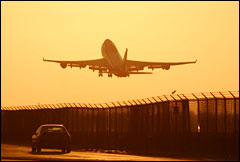Hi Umbra,
Which is less harmful to the environment when traveling long distances, flying or driving? A jet puts out a lot of exhaust, but since it carries a lot of people, maybe it’s less than having everyone drive themselves?
Craig
Denver, Colo.
Dearest Craig,
Jeepers it was fun to find out the answer to this question for you — the Math Whiz has joined me in the basement, and we are dorking out on carbon emissions on your behalf. Here’s what we think: airplanes and cars are roughly comparable on CO2 emissions, but certain particularities of airplanes, particularities that are only beginning to be understood, likely make them worse, overall, than cars.

Dilemma a la mode.
Photo: iStockphoto
Cars and planes have a range of emissions. Some cars get more miles to the gallon, some planes are more efficient than others. Some car trips are loaded with the whole family and the dogs, others are driver alone; some planes fly from Denver to Tucson, some fly from Denver to Thailand. Let’s go over what the Nobel Prize-winning Intergovernmental Panel on Climate Change has to say on the matter. If you like, follow along, in “Aviation and the Global Atmosphere” — we’ll be looking at figure 8.4. Long-haul planes emit fewer warming gases than medium and short-haul planes, because landing and takeoff are the big emissions culprits; long-haulers emit about 32 grams of carbon per passenger-kilometer, short-haulers about 100 g/p-km. The Nobellers show the least-emitting car as a small two-passenger spewing about 20 g/p-km, whereas the most emitting would be a light truck with only a driver inside, at about 99 g/p-km. So you see, the two sets of numbers are roughly comparable. But wait!
Cars travel on the ground, whereas a plane flies quite high and fast, and does not follow road routes. These differences, which we all learned at around age 3, turn out to have serious effects on the relative impact of transport emissions. Planes emit their climate-changing gases higher in the atmosphere than do cars, and hence have a distinct, stronger effect on climate. Apparently to attempt an accurate whole measurement of air travel’s climate impact, one needs to account for “radiative forcing”: how the released gases, including nitrogen oxides and water vapor, alter the radiation entering our atmosphere. The science of radiative forcing is quite complex and in flux, what with the variety of flights and the changes in weather and the uncertainties of science and so forth, hence airplane emissions are often calculated by multiplying the carbon emissions with a set number. The Nobel Prize-winning IPCC sets a multiplier of 2.7.
If you are deciding between cars and planes on a particular route, you can get even more specific than “cars are probably better than planes, what with this radiative forcing.” The average U.S. car emits approximately 9 kilograms of CO2 per gallon; the average, 22-mpg American car therefore emits about 0.4 kg CO2 per mile. Do the math for your car on the anticipated journey. To calculate the airplane emissions from an identical trip, try the offsetter atmosfair’s emissions calculator, which includes radiative forcing. Then compare. Atmosfair’s description of its calculator’s calculations is also a helpful description of all the known factors involved in air-travel emissions. Is that more information than you need, or what?
I am obliged to remind us all of the bus and the train. Buses are cheap and trains are fun. Did you know that Amtrak has a frequent-rider program akin to a frequent-flyer program, called Guest Rewards? Of course, buses and trains don’t always fit into our modern schedules, but we should use them when we can to avoid planes and cars.
Forcefully,
Umbra


